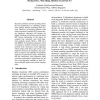Free Online Productivity Tools
i2Speak
i2Symbol
i2OCR
iTex2Img
iWeb2Print
iWeb2Shot
i2Type
iPdf2Split
iPdf2Merge
i2Bopomofo
i2Arabic
i2Style
i2Image
i2PDF
iLatex2Rtf
Sci2ools
ACL
2009
2009
A Comparative Study of Hypothesis Alignment and its Improvement for Machine Translation System Combination
Recently confusion network decoding shows the best performance in combining outputs from multiple machine translation (MT) systems. However, overcoming different word orders presented in multiple MT systems during hypothesis alignment still remains the biggest challenge to confusion network-based MT system combination. In this paper, we compare four commonly used word alignment methods, namely GIZA++, TER, CLA and IHMM, for hypothesis alignment. Then we propose a method to build the confusion network from intersection word alignment, which utilizes both direct and inverse word alignment between the backbone and hypothesis to improve the reliability of hypothesis alignment. Experimental results demonstrate that the intersection word alignment yields consistent performance improvement for all four word alignment methods on both Chinese-to-English spoken and written language tasks.
ACL 2009 | Computational Linguistics | Hypothesis Alignment | Word Alignment | Word Alignment Methods |
Related Content
| Added | 16 Feb 2011 |
| Updated | 16 Feb 2011 |
| Type | Journal |
| Year | 2009 |
| Where | ACL |
| Authors | Boxing Chen, Min Zhang, Haizhou Li, AiTi Aw |
Comments (0)

